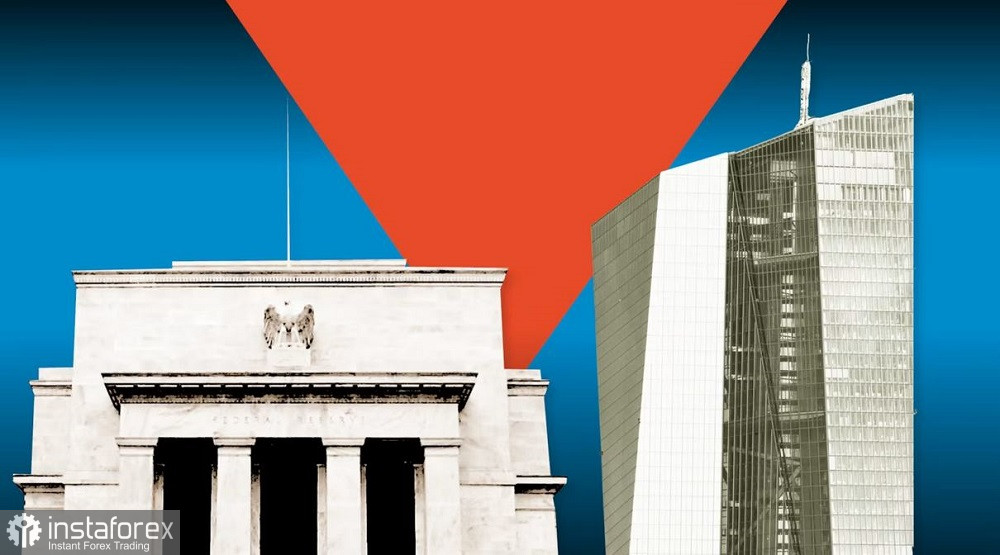From the European Central Bank, signals of a dovish nature are increasingly emerging, indicating that the regulator will begin lowering interest rates at the June meeting. The latest reports on CPI growth for March, reflecting a slowdown in inflation both in Germany and in the eurozone as a whole, only "cemented" these assumptions. This is also indicated by the minutes of the ECB's March meeting.
At the same time, opposite signals are coming from the Federal Reserve. Representatives of the Fed increasingly urge not to rush with the easing of monetary policy, pointing to the stability of high inflation. Many inflation indicators in the U.S. indeed accelerated in February (overall CPI, PPI, overall PCE), thus supporting the hawks' position.

Against the backdrop of such an information picture, it can be assumed that the European Central Bank will start lowering interest rates earlier than the Federal Reserve (i.e., in June), considering that inflation rates have decreased in Europe to a greater extent than in the U.S. Meanwhile, the American regulator may postpone the first step towards easing monetary policy until autumn or even December.
Of course, much will depend on the dynamics of key inflation indicators in the U.S. (whose March values we will learn next week), but for now, the situation is shaping up this way. And if the consumer price index and the producer price index show "stubbornness" in March, the prospects for the Fed in June will be called into question. Attention will gradually shift to September.
According to the CME FedWatch Tool, the probability of a Fed rate cut at the June meeting is currently 59%. If the inflation releases next week come out in the green zone, this probability will decrease to approximately 40% or lower. After all, in this case, all calls from the Fed not to rush with the rate cut will be projected onto the June meeting rather than the May one.
By the way, the "May factor" explains the phlegmatic reaction of the greenback to fairly hawkish statements by Fed representatives. Several members of the American regulator with voting rights (either by position or rotation) have stated that premature easing of monetary policy will do more harm than good. Jerome Powell, Christopher Waller, Raphael Bostic, and Adriana Kugler either directly or implicitly made such statements.
However, despite these almost direct verbal interventions, the dollar reacted calmly to them. Probably because all calls to maintain the status quo from the Fed representatives were made in the context of the nearest meeting, the results of which we will learn on May 1. However, the market has long incorporated such an outcome into current prices. According to the CME FedWatch Tool, the probability of maintaining a wait-and-see position at this meeting is 99%.
As for the prospects of the June meeting, Fed members cannot currently speculate practically, as it is unknown which way inflation and the labor market will turn. Before the June meeting, there will be at least two inflation reports (for March and April, possibly May data will also be published before the June meeting) and three labor market reports (including today's Nonfarm Payrolls for March). If inflation continues to accelerate and the labor market does not cool down, the prospects for a rate cut in June will dissipate.
Regarding the ECB, there are no doubts about lowering rates in June. According to a recent survey conducted by Bloomberg among economists, the European Central Bank will start lowering rates in June and will reduce them once a quarter, completing this cycle by the end of 2025.
It is also worth noting that the markets are pricing in a 90-basis-point rate cut by the ECB in 2024, compared to the expected 75-point cut by the Fed (if the June forecast is not revised in a dovish direction, which is quite likely).
According to economists surveyed by the Financial Times, it will be "practically impossible" for the European regulator to postpone the rate cut from June to a later time, given the slowdown in inflation and the actual stagnation of the eurozone economy. While the Fed does not face such pressure – the U.S. economy is growing faster, and inflation is moving too slowly towards the target level.
Today, the decoupling of ECB and Fed rates has a presumptive (though quite obvious) nature, allowing buyers of EUR/USD to afford upward price spikes. We witnessed one such spike this week. But next week, the situation may change radically, provided two conditions are met: 1) if the ECB announces a rate cut in June after the April meeting (which is highly likely); 2) if key inflation indicators in the U.S. accelerate or remain at the previous (February) level.
In this case, the divergence between the Fed and the ECB will "come to life" in new colors, allowing dollar bulls to assert themselves again.
Thus, long positions on the EUR/USD pair in the medium term still look risky. Impulse price spikes upward are not supported by a "fundamental basis": there are no solid grounds for sustainable price growth at present. Nor can we exclude the possibility that next week the ECB will take a dovish position again, and inflation in the U.S. will accelerate again.
Therefore, rushing to buy EUR/USD is not worth it: in the current conditions, it is advisable to either stay out of the market or consider short positions with the first target at 1.0800 (Tenkan-sen line on the D1 timeframe).
 English
English 
 Русский
Русский Bahasa Indonesia
Bahasa Indonesia Bahasa Malay
Bahasa Malay ไทย
ไทย Español
Español Deutsch
Deutsch Български
Български Français
Français Tiếng Việt
Tiếng Việt 中文
中文 বাংলা
বাংলা हिन्दी
हिन्दी Čeština
Čeština Українська
Українська Română
Română

